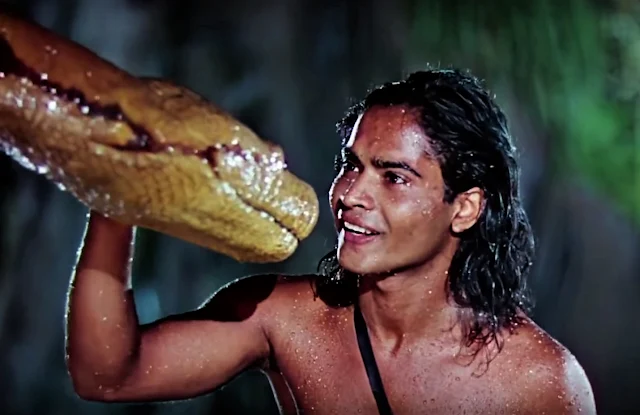 |
| Vince Barnett, Paul Muni, and Karen Morley in Scarface |
Tony Camonte: Paul Muni
Cesca Camonte: Ann Dvorak
Poppy: Karen Morley
Guino Rinaldo: George Raft
Angelo: Vince Barnett
Johnny Lovo: Osgood Perkins
Tom Gaffney: Boris Karloff
Inspector Guarino: C. Henry Gordon
Mama Camonte: Inez Palange
Director: Howard Hawks
Screenplay: Ben Hecht, Seton I. Miller, John Lee Mahin, W.R. Burnett
Based on a novel by Armitage Trail
Cinematography: Lee Garmes, L. William O'Connell
Set designer: Harry Oliver
Film editing: Edward Curtiss
Like so many early talkies,
Scarface feels a little off in its pacing at times, especially in scenes with dialogue, as if the director was uncertain how much of the exposition was getting across to the audience. Which is surprising, considering the director is Howard Hawks, the master of fast-paced repartee. But the real Hawks shows up eventually, especially in the action scenes, and in some brilliant bits, such as the murder of Boris Karloff's Tom Gaffney in the bowling alley. We see Gaffney start to fall after the shot, but the camera follows the track of the ball he has just bowled: It's a strike, but one pin wobbles uncertainly for a second before toppling.
François Truffaut commented on the scene, "This isn't literature. It may be dance or poetry. It is certainly cinema." For many, Hawks's
Scarface has been overshadowed by Brian De Palma's 1983 version, and its rough contemporaries
Little Caesar (Mervyn LeRoy, 1931) and
The Public Enemy (William A. Wellman, 1931), the gangster films that set Edward G. Robinson and James Cagney on their road to fame, shadowed the Hawks film at the time, delaying its release as Hawks and producer Howard Hughes wrangled with the Hays Office censors, who were edgy about the plethora of gangster films. In response to their objections, the film has no fewer than three screens full of text before the movie actually starts, proclaiming that it's "an indictment of gang rule in America and the callous indifference of the government to this constantly increasing menace," and exhorting the audience to demand that the government do something about it. Later there are clearly interpolated scenes that suggest some of the things the government can do include gun control and immigration reform or even the imposition of martial law. The film was even released with a subtitle,
Scarface: The Shame of a Nation. This heavy-handedness suggests that Hughes had less clout with the Hays Office than did Warner Bros., which didn't jump through quite so many hoops in releasing
Little Caesar and
The Public Enemy. Nevertheless,
Scarface was a box office success, largely because it's a hugely entertaining film, showcasing what may be Paul Muni's best screen performance -- the only other contender would be
I Am a Fugitive From a Chain Gang (Mervyn LeRoy, 1932). Muni has a leering, gleeful quality as Tony Camonte; he's almost sexy, which is something that would never be said of the actor after he began to take himself seriously in William Dieterle's stodgy biopic celebrations of Great Men like
The Story of Louis Pasteur (1936) and
The Life of Emile Zola (1937). Because
Scarface was made before the Production Code clampdown on sex, it's pretty clear what's going on between Tony and Karen Morley's Poppy, but also that Tony's relationship with his sister, Cesca, has a touch of the perverse about it. The film is full of delicious asides, too, like a minor character, a reporter known as "MacArthur from the
Journal," a tip of the hat to screenwriter Ben Hecht's former colleague in Chicago journalism, Charles MacArthur, who was also his co-writer on the play
The Front Page. The character is played by Hecht and MacArthur's friend John Lee Mahin, one of the screenwriters on
Scarface.






